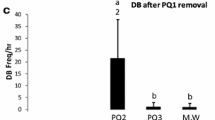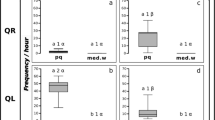Summary:
Bombus atratus, a bumble bee found throughout much of South America, undergoes periods of polygyny during its colony cycle, which is often perennial. This temporary polygynous phase persists as multiple queens compete fiercely to become the sole reproductive. The outcome of these battles is death or expulsion from the nest of all but one of the queens, representing an extreme form of conflict of reproductive interests. We examined various factors which may influence survival and succession of rival B. atratus queens during a polygynous phase of a colony found in southern Brasil. Queens exhibiting greater ovarian development and a higher frequency of inter-queen aggression in the early period of polygyny survived significantly longer. Body size did not appear to contribute to the outcome of queen survival.
Similar content being viewed by others
Author information
Authors and Affiliations
Additional information
Received 5 June 1997; revised 30 October 1997; accepted 10 November 1997.
Rights and permissions
About this article
Cite this article
Cameron, S., Jost, M. Mediators of dominance and reproductive success among queens in the cyclically polygynous Neotropical bumble bee Bombus atratus Franklin. Insectes soc. 45, 135–149 (1998). https://doi.org/10.1007/s000400050075
Issue Date:
DOI: https://doi.org/10.1007/s000400050075




